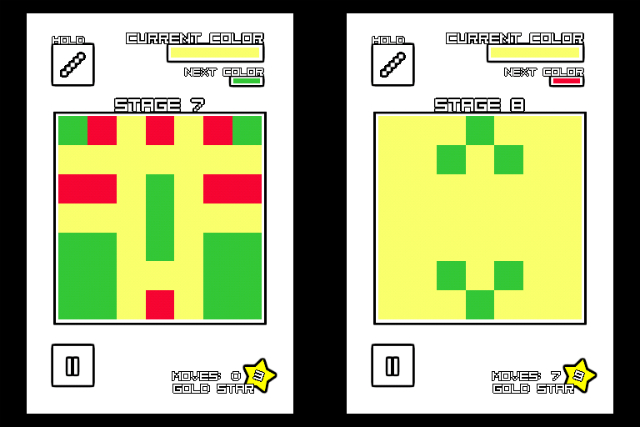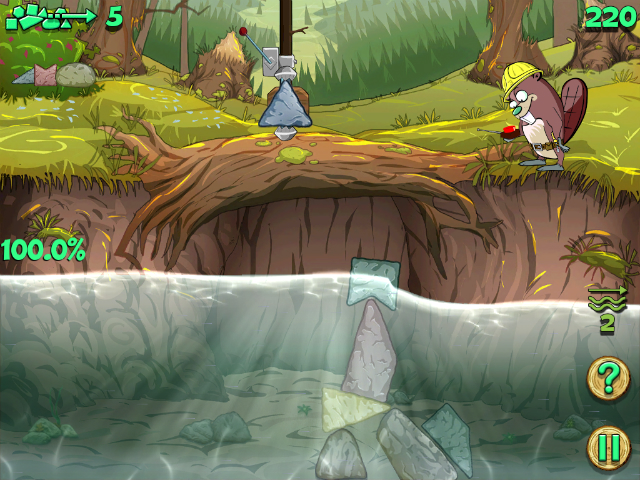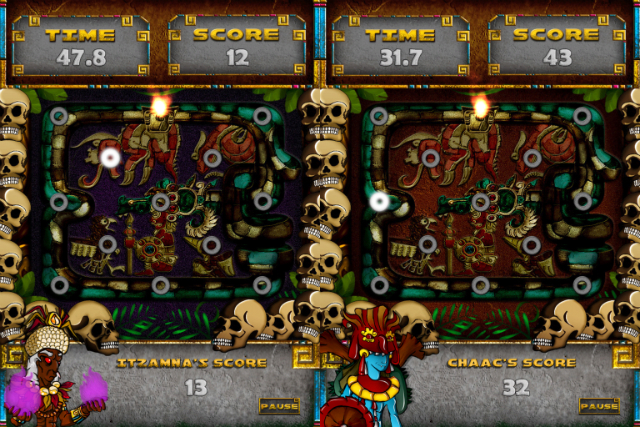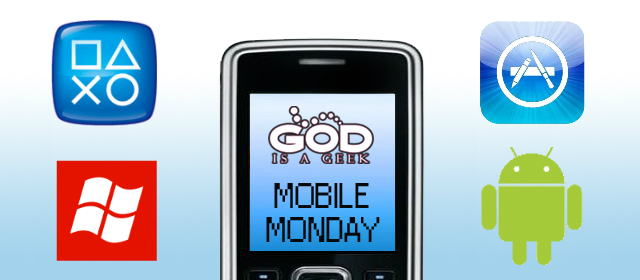You know what day it is? It’s Monday again and that can mean only one thing here at GodisaGeek.com: It’s time for another edition of Mobile Monday, the article where we take a look at four mobile games and let you know if they’re worth your time and money.
This week we’re taking a look at Puzzle Colors from Reload Game Studio, Eager Beaver from Gamagio, The Lightfall Codex from EnsenaSoft and David Haye’s Knockout from our friends over at Grubby Hands.
Read on to find the full reviews of each game and don’t forget to come back next week for the reviews of another four games. While you’re here, if you have played any of the games listed, or even just want to come back once you’ve had a go to let us know how you got on, we’d love to hear from you in the comment box at the bottom of the page.
Get downloading and get playing!
Titles are available on iPhone and iPad unless specifically stated otherwise. If you like what you read, click the small black “App Store” button to load iTunes up and purchase the title!
![]() PUZZLE COLORS:
PUZZLE COLORS:
We all enjoy a decent puzzle game from time to time, it doesn’t matter if they’re based around words, numbers or even colours, as long as they test our mental ability adequately enough we’ll tend to keep coming back to them time and time again. Puzzle Colors (excuse the “incorrect” spelling of the word, it’s just how it’s written), developed by Reload Game Studio, is a game that focuses on matching colours, and while that may sound like a simple enough concept on paper, I assure you, when you get into the game, especially the later levels, things are far from simple.
The aim of Puzzle Colors is to get the entire square into the same colour, it doesn’t matter which of the available colours it is at the end, as long as it’s all the same colour you’ll beat the level and move on to the next stage. The game works in a fashion similar to Tetris in that you’re shown the current colour that you can place down as well as the next colour and that’s it. You’re also able to “Hold” a colour for use at a later time if you so wish. This functionality is often required for the later level where colours seem to be put into the queue for the simple reason of confusing the player. Just like any other puzzle game.

Of course, it wouldn’t be an iOS puzzle game without a way of completing the level and then a way of really completing the level. In Puzzle Colors this takes the form of Gold Stars. If you manage to complete the puzzle within a set number of moves then you’ll be awarded with one of the elusive Gold Stars, which the player has to collect in order to unlock more levels in the game. Getting these Gold Stars is no mean feat either, even the very first level will take quite a few attempts and some out-of-the-box thinking in order to complete the puzzle in the two moves that are required for that level. It’s often extremely difficult but if you enjoy the game, and want more levels, it’ll be something that you’ll undoubtedly be happy to do.
It couldn’t be easier to play Puzzle Colors, it’s one of those games that anyone can pick up and play once they understand the rules of the game. The gameplay itself might take a little bit to get used to, especially with all the nuances and tactics that comprise some of the later levels, but once you’ve got the hang of them, there’ll be nothing stopping you from playing hours on end, if that’s what you want to do. The barrier for entry is low too. Everyone loves a decent puzzle and Puzzle Color is a game that everyone, young or old, would enjoy playing if they’re given half a chance. So give it a chance! 

![]() EAGER BEAVER:
EAGER BEAVER:
Just as much as some games have names that oversell the content within them, there are games with subtle titles that do a disservice to the game that the developers have created, sometimes sounding a little bit more standard than they no doubt intended. Eager Beaver is a game that is a little bit standard, and the icon doesn’t really help it along either, but is the game as standard as it seems on the face of it, or is it something a little bit special once you peel back the layers?
You play the game as Edgar, a truly “Eager Beaver” who simply loves building dams. He loves it so much that all the other beavers have stopped working and become rather lazy; why bother doing anything if you’ve got somebody in your midst who’s prepared to do all the work? All that laziness comes back to bite them though, when a huge wave sweeps through the village forcing Edgar (you) to build a plethora of dams using only the materials you have lying around (some rather oddly shaped blocks) before the entire village is wiped out.

The blocks that you pick up are constantly spinning, so it’s your job to let them go in such a way as to build the blocks on top of each other to stop the water. Some of the time this is a simple task, especially when all you’re dealing with is small, square blocks. Soon though, you’ll have to deal with other shapes, shapes that aren’t so easy to stack on top of each other; especially not when you’re dropping them from a height too. The task in each level is to stack the blocks high enough to stop the water running, you’ll be awarded stars at the end of the level (just like a lot of these games do) based on how quickly you managed to complete the level as well as how few blocks you were able to use; the fewer blocks you use, the more points (and therefore more stars) you’ll attain once the level ends.
The controls are extremely easy to grasp, simply move your finger across the screen while holding the crane to determine where along the floor you’re going to drop the next block, then let go of the screen to drop. There’s no way to control the spinning of the crane so you’ve got to try and judge the speed accordingly. If you want those higher scores, and are wanting the blocks in an extremely specific fashion, then you’re going to be spending a lot of time practising. It’s by no means easy.
Eager Beaver is a game that’s not too difficult to pick up but hard to put down. The crisp, bright visuals alone will keep you wanting to come back for more and while the gameplay does become a little stagnant after long game sessions, it’s always easy to come back for more at a later date. Gamagio have created a game that can – and should – be played by people of all ages, it won’t be the “next big thing” but it’s certainly worthy of a download and a play. 

![]() THE LIGHTFALL CODEX:
THE LIGHTFALL CODEX:
Every so often there’s a game that appears in my pile of games for Mobile Monday that just sounds epic, it’s got a name that automatically gets me intrigued as to what the game could possibly be about; and I’m sure these type of games have the same effect on a lot of people. That’s why it’s so important not to judge a game by its name (or icon), just because it looks or sounds good doesn’t mean that the game itself it going to play well. The Lightfall Codex, developed by EnsenaSoft, falls into the category of a game with a name that is likely to make people take notice a little bit; but is it worth playing at all?
The main aspect of the game tasks the player with tapping on the screen in very specific places, areas of the game world that look like little metal rings, as they light up. It’s basically a glorified ‘whack-a-mole’ game. The further you get into the game, the faster the lights will light up, increasing the difficulty as you’ve got to try and tap every single one in order to get the better scores. In each level you’ll be facing off against an A.I. opponent, a Mayan god, and you’ve got to get more correct taps than them to progress to the next level; that’s it.

Unfortunately that’s all the game consists of, every so often they’ll throw a curveball into the mix, tasking you with tapping all of the rings except the ones that flash for example, but there’s never anything new or interesting enough to keep you playing for the long term. Once you’ve played the first few levels you’re likely to put the game down and never pick it back up again. It’s especially disappointing because the story that’s given the player, about an adventurer having to find the Lightfall Codex in order to save the world from the fury of the Mayan gods, is actually quite an interesting one and to see it attached to such a lacklustre game concept is a shame.
As you would expect from a game concept that’s so simplistic, the controls are easy to grasp, with all that’s required from the player is to tap the screen as the rings light up. The barrier to entry is rather low, which is always good to see, but whether or not the people that never play games would be interested in a game that’s so repetitive is another matter entirely.
It’s hard to recommend The Lightfall Codex, on one hand it has a relatively interesting story, one that could have worked quite well if it was attached to a game that was in any way interesting to play. The fact remains that while The Lightfall Codex is easy to play, it’s probably one that would be better off skipped. There are plenty of decent iOS games out there and, sadly, this isn’t one of them. 

![]() DAVID HAYE’S KNOCKOUT:
DAVID HAYE’S KNOCKOUT:
There aren’t many people in the sporting world who are treated to their own iOS title. In fact I’d could probably only name them on one hand, but the former WBA Heavyweight Champion David ‘Hayemaker’ Haye is one of those people. The developers behind the game – our friends over at Grubby Hands – have put together a game similar in visual appeal and gameplay to Punch-Out, the game that we all probably had one or two goes on in our younger years. You can attach a famous name to any game though, that doesn’t mean it’s going to be any good. Is that the case for David Haye’s Knockout?
The gameplay revolves around boxing, as your main task with each fight is to take the person opposing you down as quick as you can and without taking any hits. If you can do that then maybe you’re the kind of person who will be able to rise to the top of the boxing ranks and get the chance to face off against the unnamed (yeah, as if we don’t know who it’s supposed to be) Eastern European giant. Punching is relatively easy, you’re given four buttons and just told to alternate between them in order to do more damage, but the difficulty lies in attempting to dodge the incoming attacks. You’re only given a few fractions of a second to react to the incoming attack otherwise you’re going to get hit in the face and, more importantly, you’re going to lose some of the power-up charge that you’ve been saving up.

The Hayemaker is the game’s special move and, in order to be able to perform it, you’re going to have to batter your opponent to a pulp while attempting not to get hit yourself. If you get hit you lose some of the power-up that you’ve been charging and you’ve got to build it all back up again. It’s not easy to build up the Hayemaker power-up but it’s certainly something you’re going to want to do if you want to take down the big dogs as fast as you possibly can; further adding to the disappointment you’ll feel towards yourself when you don’t dodge that incoming punch fast enough.
The controls are fairly easy to get a grasp on, although if you don’t delve into the ‘Help’ section of the game to begin with then you’re not going to know that there’s a dodge function at all, nevermind not knowing how to perform it. There are the aforementioned four punch buttons and, in order to dodge all the incoming tasks, the player has to swipe the screen. This sounds like it’s going to be easy on paper, and the punching aspect of the game is, but the dodging isn’t easy at all. It’s going to take some practice to unlock some of the more difficult trophies and move on to the harder opponents but if you’re the kind of person who enjoys the game then that’s not going to be a problem for you.
The visuals of the game make it worth a download on their own; there aren’t many games out there with this type of visual style that move as fluidly as David Haye’s Knockout does. The game is a little bit lacking in certain areas, it’s a little bit featureless and it’s not easy to understand what to do in the beginning, but as a package it’s certainly something that’s worth a play, even if you’re not going to be playing it for too long. 






